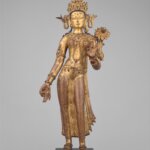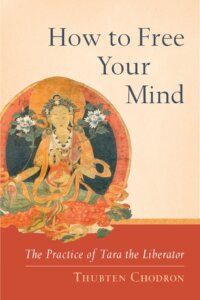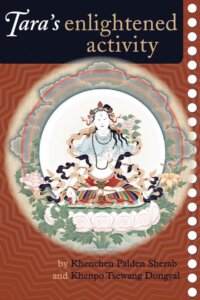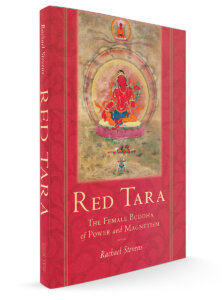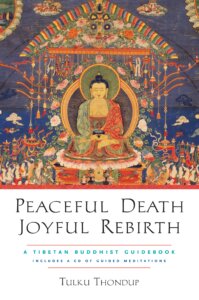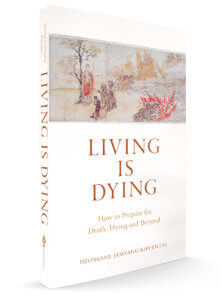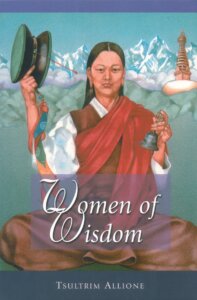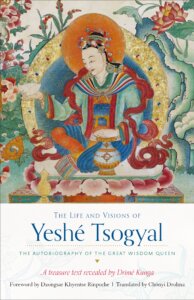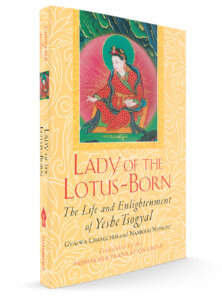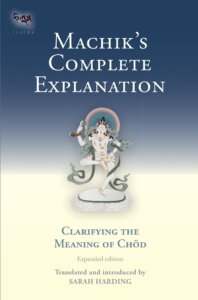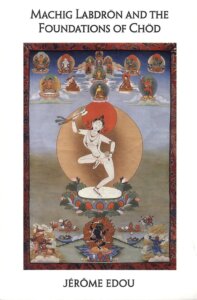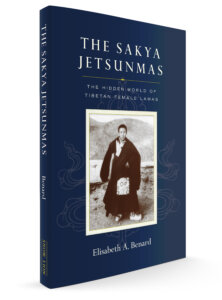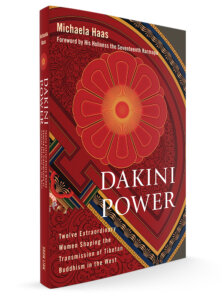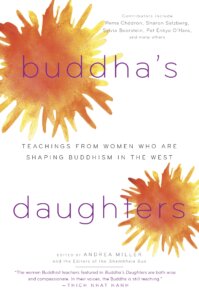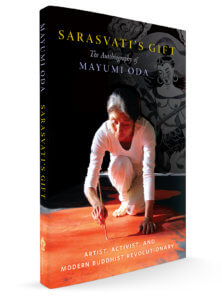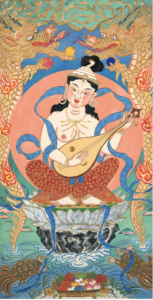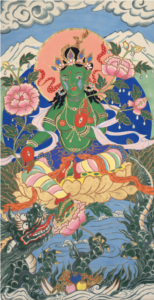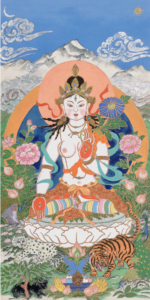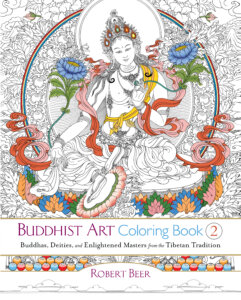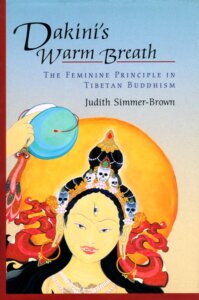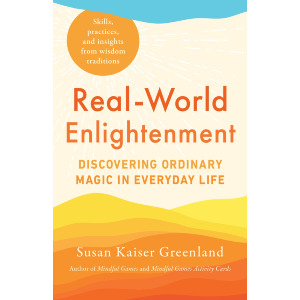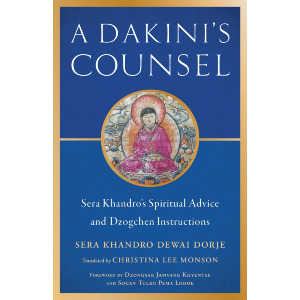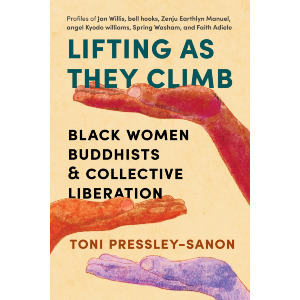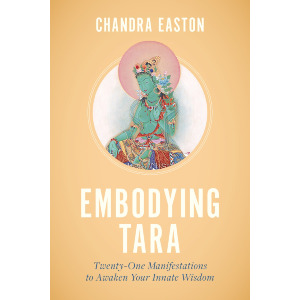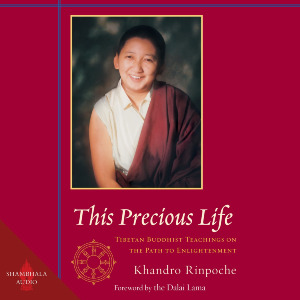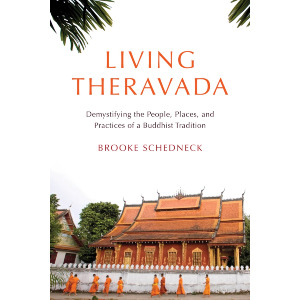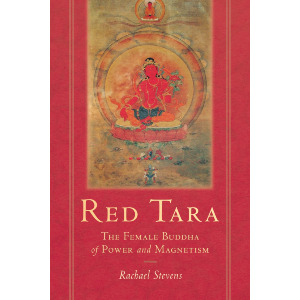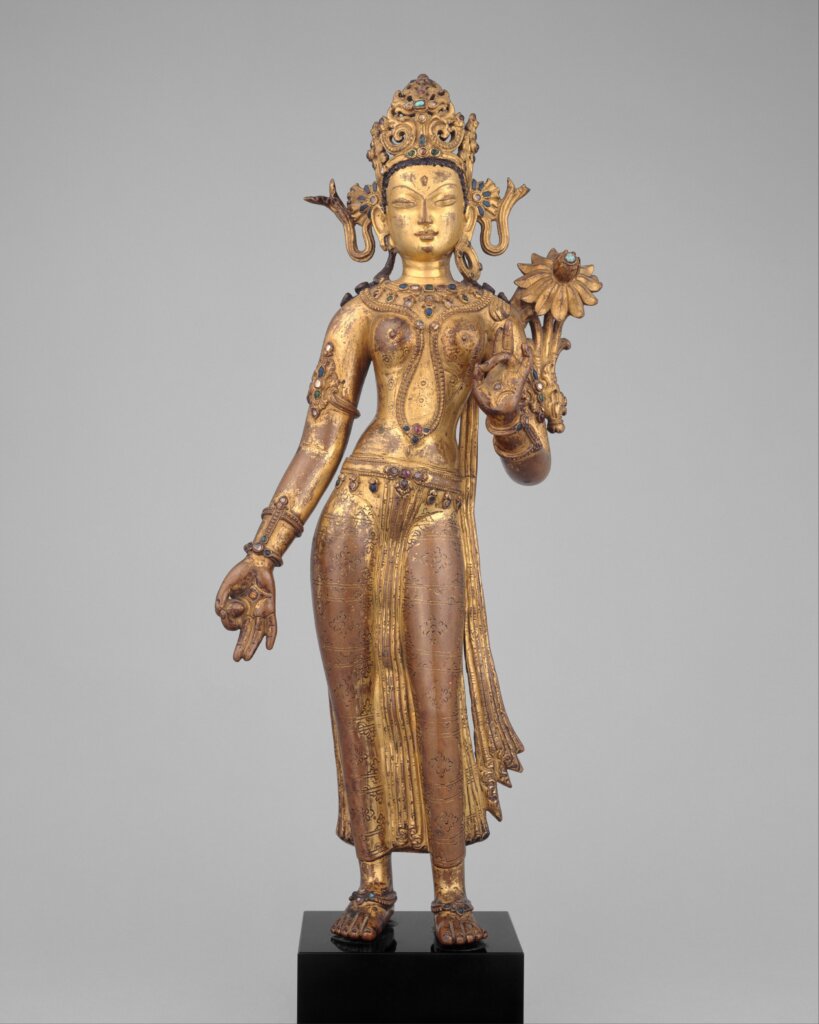
Ārya Tārā (Sanskrit), also known as Jetsun Drölma in Tibetan, or simply "Tārā" is a meditation deity and an important figure in Buddhist thought, history, and practice. While often described as a goddess or protectress, she is considered a liberator for her ability to remove obstacles, especially fear and anxiety. In fact, the Tibetan "Drölma" literally translates to "liberator" describing her ability to expel negativity and free her devotees from suffering.
Recognized in all schools of Tibetan Buddhism, variations of the Praises to the Twenty-One Taras are often heard in both the monastic and lay Tibetan communities. Likewise, it is common for practitioners to simply recite the main Tārā mantra in both formal meditation and throughout the day during regular activities:
Oṃ Tāre Tuttāre Ture Svāhā
In addition to being thought of a liberator, she's regarded as a bodhisattva and often considered the female counterpart to Avalokiteshvara, the bodhisattva of compassion. Some stories, in fact, explain that Tārā was born from the tears of Avalokiteshvara after witnessing the myriad suffering of the six realms of existence.
In another story, Tārā is described as princess Yeshe Dawa who, having been told she could not attain enlightenment in a female body, vowed to do so and to then remain in the world as an example of buddhahood in a female body.
In yet another origin story, some scholars believe Tārā is derived from the Hindu goddess Durgā described in the Puranas. Also described as a motherly protectress, Durgā is believed to provide strength and protection while combating obstacles to peace and prosperity.
There are countless stories, histories, and theories about the origins of Tārā in addition to meaningful practices for connecting with her benevolent power and coming under her protection. Below you'll find a selection of books related to Tārā and related female deities.
The 21 Praises to Tara
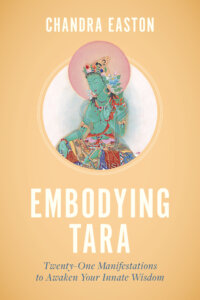
Available for preorder Fall 2023 - on sale 12/12/2023
Embodying Tara: Twenty-One Manifestations to Awaken Your Innate Wisdom
by Chandra Easton
Tara, the Buddhist goddess of compassion, can manifest within all of us. In this illustrated introduction to Tara's twenty-one forms, respected female Buddhist teacher and practitioner Dorje Lopön Chandra Easton shows you how to invite Tara’s awakened energy to come alive in yourself through:
- insight into core Buddhist concepts and teachings;
- meditations;
- mantra recitations; and
- journal exercises.
The relatable stories from Buddhist history and the author’s personal reflections will give you the tools to live a more compassionate life, befriend your fears, and overcome everyday challenges.
Find out how important women and movements in modern history have achieved this through their own embodiment of Tara's enlightened activities. The stories of Jane Goodall, Nawal El Saadawi, Oprah Winfrey, Vandana Shiva, Black Lives Matter, Me Too, and others will inspire you to bring these aspects of Tara into the world in creative and socially conscious ways for the benefit of all.
How to Free Your Mind: The Practice of Tara the Liberator
Tara, the feminine embodiment of enlightened activity, is a Buddhist deity whose Tibetan name means “liberator,” signaling her ability to free beings from the delusion and ignorance that keep them trapped in ever-recurring patterns of negativity. She embodies a challenge, but one that is profoundly nurturing: to transform our minds and become like her, reflecting the tranquility, compassion, and wisdom that make her so beautiful.
Thubten Chodron describes a simple meditation on Tara, explaining its benefits and its application to daily life. She also presents two well-loved praises—“Homage to the Twenty-one Taras” and “A Song of Longing for Tara, the Infallible”—together with reflections on their meanings for modern practitioners.
Tara's Enlightened Activity: An Oral Commentary on "The Twenty-one Praises to Tara"
By Khenchen Palden Sherab
By Khenpo Tsewang Dongyal
The female Buddhist deity Tara is an object of devotional worship and meditative practice for Tibetan Buddhists everywhere, both male and female. She clears away fears, overpowers negative emotions, and enables all beings to reach enlightenment. She has special resonance as a source of female spiritual wisdom. Tibetans of all schools and traditions recite the verses on which this commentary is based. Focused contemplative meditation in relation to the myriad aspects of Tara works to transform the practitioner's mind into those enlightened qualities and mind states that Tara represents. Sought-after teachers throughout the West for over twenty-five years, Khenchen Palden Sherab Rinpoche and his brother Khenpo Tsewang Dongyal Rinpoche illuminate the practice of the Praises to the Twenty-one Taras with humor and wisdom. The explanations cover progressively more subtle levels from basic Buddhism through the Inner Tantras and culminate with Dzogchen. Interspersed with lively stories about Tara, the authors explain the physical conditions for practice, the outer and inner meanings of the text itself, and give solutions for problems that may emerge as practice progresses.
Wake Up to What Matters: A Guide to Tibetan Buddhism for the Next Generation
While not specifically a book about Tara, Wake Up to What Matters includes a chapter called "As Fearless as Tara," which emphasizes the protective power of using Tara as a meditational deity and by recalling her obstacle removing qualities. As a young Tibetan teacher, Avikrita Rinpoche has a unique and fresh voice among his peers. Sharing his appreciation of Tara practice he states:
When we practice the Tara visualization in meditation—or any Vajrayana meditation, actually—the self-generation always starts with something like “From the state of voidness . . .” Some people might think, “OK, here I am, sitting with all my faults and problems, and I try to imagine everything disappears into a state like space, then I pretend to look like this pretty lady, a much better personality than me. . . .” That’s totally wrong. The profound thing is that, right from the very beginning, we stop thinking of ourselves in relative, dualistic terms. We open our hearts to the experience, the understanding of voidness, and then that mind itself manifests as Tara. It’s not the ordinary “I” at all, otherwise Vajrayana practices would be counterproductive to liberation. So each time we’re practicing such meditation properly, we’re getting closer and closer to the realization of Tara this way. That is how we can experience the power to be really fearless, to have the fearless ultimate bodhichitta.
Common Forms of Tara
While there are 21 forms of Tara, the are a couple manifestations that are more commonly practiced among Buddhist communities including White Tara, Green Tara, and Red Tara. Below you'll find a couple examples of practices associated with specific forms of Tara found in our books.
Red Tara
Red Tara: The Female Buddha of Power and Magnetism
Tara is one of the most celebrated goddesses in the Buddhist world, representing enlightened activity in the form of the divine feminine. She protects, nurtures, and helps practitioners on the path to enlightenment. Manifesting in many forms and in many colors to help beings, Tara’s red form represents her powers of magnetization, subjugation, and the transformation of desire into enlightened activity. She is considered to be particularly powerful in times of plague and disharmony.
This comprehensive overview focuses on the origins, forms, and practices of Tara, providing the reader with insightful information and inspirations relating to the goddess. Its second part focuses on Red Tara, a powerful and liberating form of Tara that is particularly important to connect with in a time of crisis. These chapters cover various forms of Red Tara found throughout the Tibetan Buddhist world, the particular qualities she represents, and how through prayers and meditation we can embody her principles and truly benefit beings.
Learn more about Red Tara by Rachel Stevens in this positive review from Judith Simmer-Brown on H-Net.
White Tara
White Tara often appears as a guide to beings who are traversing the bardo after death. While we don't have a book dedicated to White Tara, the following include several references to her help and presence during the intermediate stages.
Peaceful Death, Joyful Rebirth: A Tibetan Buddhist Guidebook
Again, while not a dedicated book on White Tara, in the chapter called "Tales From the Bardo," Tulku Thundup shares the afterlife accounts of Tibetan Delogs. Delogs, are those who have "returned from death," and often female. In the story of Karma Wangdzin, Karma is met with a woman in white robes who who turns out to be White Tara appearing as a guide during her transition. When greeting Karma in her grief, White Tara exclaims:
Kyema! Don’t feel sad. Get up!
When afflicting emotions trample you, if you don’t realize their true
nature,
Claiming to have Dharma experience is a lie and is cruel.
“Birth and death are the fruition of human life.
They happen again and again”—the Buddha has said.
Death is not occurring only to you.
Only by this path, all beings must go.
I will accompany you so that you may travel in peace.
Living is Dying: How to Prepare for Death, Dying and Beyond
In Living is Dying, Dzongsar Khyentse Rinpoche describes the various pure lands that people can be born into depending on the inclination and practice during their lifetime. Pure relams include the Copper Colored Mountain of Guru Rinpoche, Amitabha's Sukhavati, and Tara's Land of Turquoise Leaves. He explains that:
In Arya Tara’s buddha realm, all the living beings are female—the bodhisattvas, the birds, the tigers, everyone. Arya Tara resides at the center of a magnificent, transparent lapis lazuli palace. She is swift to act, peaceful, resplendent and surrounded by buddhas, bodhisattvas and hundreds and thousands of dakinis whose wisdom minds overflow with love and compassion.
Historical Emanations of Tara
Throughout history, Buddhists have recognized different women as emanations of Tara. For example, Yeshe Tsogyal, the principle consort of Guru Rinpoche, was considered an emanation of Tara. Another example is 11th century Tibetan yogini, Machik Labdron, known for developing the practice of Chöd.
Women of Wisdom explores and celebrates the spiritual potential of all women, as exemplified by the lives of six Tibetan female mystics. These stories of great women who have achieved full illumination, overcoming cultural prejudices and a host of other problems which male practitioners do not encounter, offer a wealth of inspiration to everyone on the spiritual path.
In this revised and expanded edition, Tsultrim Allione's extensive autobiographical preface and introduction speak directly to the difficulties and triumphs of women in the West who pursue a spiritual life, as she shares her own stories and experiences. Women of Wisdom offers valuable insights to all those interested in women's spirituality, regardless of background or tradition.
Yeshe Tsogyal
The Life and Vision of Yeshe Tsogyal: The Autobiography of the Great Wisdom Queen
By Drime Kunga
Foreword by Dzongsar Jamyang Khyentse
By Yeshe Tsogyal
Translated by Chonyi Drolma
The many layers of the heroic life of Yeshé Tsogyal, Tibet’s best-known dakini and female master, are revealed in this inspiring work. Translated here for the first time, this terma, or “hidden treasure,” presents an outer narrative of her birth, family, and struggles in a traditional male-dominated society; an inner account of her meetings with the great master Padmasambhava; and a secret chronicle of her retreat at Chimpu and her visionary journey to Oddiyana. This accomplished translation is enriched by the refreshing insights of six contemporary scholars and teachers of Tibetan Buddhism, making this invaluable guide to the life of Yeshé Tsogyal a treasure for practitioners, scholars, and anyone intent on the possibility of awakening.
Lady of the Lotus-Born: The Life and Enlightenment of Yeshe Tsogyal
By Gyalwa Changchub
By Namkhai Nyingpo
Translated by Padmakara Translation Group
By Yeshe Tsogyal
The first Tibetan to attain complete enlightenment was in all probability the woman Yeshe Tsogyal, the closest disciple of Padmasambhava, the master who brought Buddhism to Tibet in the eighth century. This classical text is not only a biography but also an inspiring example of how the Buddha's teaching can be put into practice. Lady of the Lotus-Born interweaves profound Buddhist teachings with a colorful narrative that includes episodes of adventure, court intrigue, and personal searching. The book will appeal to students of Tibetan Buddhism and readers interested in the role of women in Buddhism and world religions.
Machik Labdron
Machik's Complete Explanation: Clarifying the Meaning of Chod
Fear, anger, and negativity are states that each of us have to contend with. Machik's Complete Explanation, the most famous book of the teachings of Machik Lapdrön, the great female saint and yogini of eleventh- to twelfth-century Tibet, addresses these issues in a practical, direct way.
Machik developed a system, the Mahamudra Chöd, that takes the Buddha's teachings as a basis and applies them to the immediate experiences of negative mind states and malignant forces. Her unique feminine approach is to invoke and nurture the very "demons" that we fear and hate, transforming those reactive emotions into love. It is the tantric version of developing compassion and fearlessness, a radical method of cutting through ego-fixation.
Machig Labdron and the Foundations of Chod
By Jerome Edou
Machig Labdron is popularly considered to be both a dakini and a deity, an emanation of Yum Chenmo, or Prajnaparamita, the embodiment of the wisdom of the buddhas. Historically, this Tibetan woman, a contemporary of Milarepa, was an adept and outstanding teacher, a mother, and a founder of a unique transmission lineage known as the Chöd of Mahamudra. This translation of the most famous biography of Machig Labdron, founder of the unique Mahamudra Chöd tradition, is presented together with a comprehensive overview of Chöd's historical and doctrinal origins in Indian Buddhism and its subsequent transmission to Tibet.
Living Emanations of Tara
Just as there are historical women that are recognized as emanations of Tara, today there is a growth in female teachers in Buddhist communities around the world. Below are a few examples of collections that share stories about modern Buddhist women who's experience as both teachers and practitioners continue to influence the fruition and preservation of Buddhism into the future.
The Sakya Jetsunmas: The Hidden World of Tibetan Female Lamas
By Jerome Edou
In The Sakya Jetsunmas, Elisabeth Benard presents the first in-depth study of the great female practitioners born into the Sakya Khon family, one of the most prestigious families of wisdom-holders in the Tibetan Buddhist tradition. These jetsunmas (“venerable women”) received the same training as their brothers, taught some of the most famous male lamas of their times, and transmitted wisdom from one female adept to another. Benard did extensive research in Tibet, India, and Nepal, collecting texts, diaries, and many interviews. In this groundbreaking book, the hidden world of the Sakya Jetsunmas is finally revealed.
Dakini Power: Twelve Extraordinary Women Shaping the Transmission of Tibetan Buddhism in the West
What drives a young London librarian to board a ship to India, meditate in a remote cave by herself for twelve years, and then build a flourishing nunnery in the Himalayas? How does a surfer girl from Malibu become the head of the main international organization for Buddhist women? Why does the daughter of a music executive in Santa Monica dream so vividly of peacocks one night that she chases these images to Nepal, where she finds the love of her life in an unconventional young Tibetan master?
The women featured in Dakini Power—contemporary teachers of Tibetan Buddhism, both Asians and Westerners, who teach in the West—have been universally recognized as accomplished practitioners and brilliant teachers whose life stories demonstrate their immense determination and bravery. Meeting them in this book, readers will be inspired to let go of old fears, explore new paths, and lead the lives they envision.
Buddha's Daughters: Teachings from Women Who Are Shaping Buddhism in the West
Edited by Andrea Miller
Edited by Editors of the Shambhala Sun
Buddhism began to take root in the West at just the same time that women’s voices were arising to find expression here—after millennia of being relegated to the background. If that was a coincidence, it was an auspicious one, for the women who emerged as Buddhist teachers have been among the most articulate of Dharma-communicators—and they remain an indelible feature of Western Buddhism as the practice matures here. The remarkable range of their teaching is showcased in this anthology. The pieces featured touch on the topics that are at the heart of our lives—relationships, uncertainty, love, parenting, food, stress, mortality, living fully, and social responsibility. These approachable, engaging teachings illuminate Buddhist concepts and practices, such as meditation, tonglen, lovingkindness, cultivating gratitude, and deep relaxation.
Artwork on Tara
By Mayumi Oda
This inspiring life story of Mayumi Oda includes 25 original full-color thangka paintings, many of which showcase Tara imagery. Mayumi Oda's life is extraordinary and exemplifies the power and strength of female practitioners both in relating with the mind and creative expression.
Drawing and coloring has become more and more popular for adults over the years! The beautiful images in these two coloring books can be used as a form of mindfulness meditation or just pure fun and enjoyment. There is a full sized image of Tara in Book 2.
Books on the Feminine Principle in Buddhism
The last book in this reader's guide is beautiful overview of the feminine principle in Tibetan Buddhism. Drawing from the point of view of psychology and Buddhist practice, Judith Simmer-Brown offers a comprehensive exploration of the feminine. Read more below.
Dakini's Warm Breath : The Feminine Principle in Tibetan Buddhism
The primary emblem of the feminine in Tibetan Buddhism is the dakini, or "sky-dancer," a semi-wrathful spirit-woman who manifests in visions, dreams, and meditation experiences. Western scholars and interpreters of the dakini, influenced by Jungian psychology and feminist goddess theology, have shaped a contemporary critique of Tibetan Buddhism in which the dakini is seen as a psychological "shadow," a feminine savior, or an objectified product of patriarchal fantasy. According to Judith Simmer-Brown—who writes from the point of view of an experienced practitioner of Tibetan Buddhism—such interpretations are inadequate.
In the spiritual journey of the meditator, Simmer-Brown demonstrates, the dakini symbolizes levels of personal realization: the sacredness of the body, both female and male; the profound meeting point of body and mind in meditation; the visionary realm of ritual practice; and the empty, spacious qualities of mind itself. When the meditator encounters the dakini, living spiritual experience is activated in a nonconceptual manner by her direct gaze, her radiant body, and her compassionate revelation of reality. Grounded in the author's personal encounter with the dakini, this unique study will appeal to both male and female spiritual seekers interested in goddess worship, women's spirituality, and the tantric tradition.

